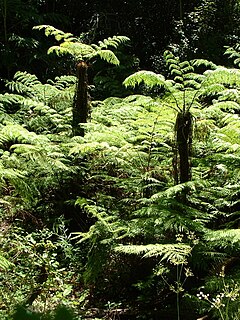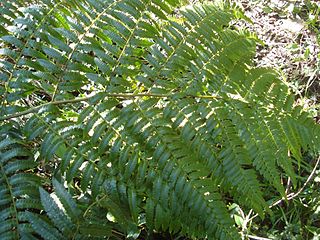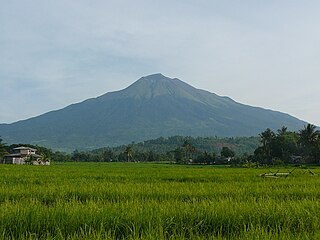
Cyathea cooperi, also known as the Australian tree fern, lacy tree fern, scaly tree fern, or Cooper's tree fern, is a tree fern native to Australia, in New South Wales and Queensland.
Cyathea affinis is a variable species of tree fern native to Fiji, Samoa, the Cook Islands, Austral Islands, Tahiti, and the Marquesas Islands. The trunk of this plant is erect and 2–6 m tall. Fronds are bipinnate and 2–3 m in length. The rachis and stipe are pale to brown in colour, or flushed with red towards the pinnule rachis. The stipe is sparsely covered in narrow basal scales, which are pale to dark and have broad fragile edges. Characteristically of this species, the lowest one or two pairs of pinnae may be slightly reduced and occur towards the base of the stipe. Sori are located near the pinnule midvein and are partially or fully covered by indusia, which open towards the pinnule margin.
Cyathea abbottii is a species of tree fern native to Hispaniola, where it grows in shaded montane forest at an altitude of 700–1200 m. The trunk is erect and can grow up to 1.6 m in height and 5 cm in diameter. Fronds may reach 1.5 m in length and are pinnate. The rachis is brown and is covered in golden-brown to bicoloured basal scales. Sori are arranged in two rows along each side of the pinnule midvein. Indusia are rounded and in the shape of a cup.
Cyathea amintae is a species of tree fern native to Puerto Rico, where it grows in shaded areas and cloud forest at an altitude of 1000–1200 m. The erect trunk may be 1.3 m tall and approximately 5 cm in diameter. Fronds are pinnate and up to 1.6 m long. The rachis is often purplish brown and covered with scales, usually on the underside. The scales range in colour from golden brown to bicoloured. Sori occur along each side of the pinnule midvein and indusia are cup-like.

Cyathea brevipinna is a species of tree fern endemic to the higher parts of Mount Gower on Lord Howe Island, where it grows in exposed areas at an altitude of about 790 m. The trunk is erect and may reach 3 m in height. It is often covered with reddish brown scales and stipe bases. This species may produce stolons at ground level. Fronds are tripinnate, densely crowded, and up to about 3 m long. The stipe is brown and sometimes warty after scales fall off. The scales are long, glossy dark brown, with a distinctly narrow apex and fragile paler edges. Sori are attached to deeply divided fertile pinnules that may uncurl over the sori. Indusia are firm and large. C. brevipinna is a stunted plant with short pinnae.

Cyathea capensis is a regionally widespread and highly variable species of tree fern. It is indigenous to Southern Africa and South America.
Cyathea cinerea is a species of tree fern endemic to Mindanao in the Philippines, where it grows in forest at an altitude of about 1000 m. The trunk is erect, up to 5 m tall and about 12 cm in diameter. Fronds are bi- or tripinnate and 1–2 m long. The stipe has long spines and scattered scales, which are either narrow and pale or wide and brown. Sori occur near the midvein of fertile pinnules and are covered by brown indusia.
Cyathea costulisora is a species of tree fern native to Sumatra. The trunk is erect and usually 1–4 m tall. Fronds are bi- or tripinnate and 1–2 m long. The stipe is covered with warts and scales. The scales are either pale and glossy or dark and flat. Sori occur near the fertile pinnule midvein and are covered by large, firm, brown indusia.
Cyathea erinacea is a species of tree fern native to Mexico, Costa Rica, Panama, Venezuela, Colombia, Ecuador, Peru and Bolivia.
Cyathea fenicis is a species of tree fern native to the Philippines, Taiwan, and Orchid Island, where it grows in wet forest, forest margins and on hillsides. The trunk is erect, up to 1 m tall and about 6 cm in diameter. Fronds are tripinnate and 1.5–2 m long. Characteristically of this species, the lowest pinnae are usually reduced. The stipe is spiny and ranges in colour from brown to purple-dark brown. It bears two types of scales: long dark brown scales as well as minute brown ones. Occasionally the scales are pale. Sori are round and arranged in two rows, one on either side of the pinnule midvein. They are covered by very small indusia that resemble scales in appearance.
Cyathea gigantea is a species of tree fern native to northeastern to southern India, Sri Lanka, Nepal to Myanmar, Thailand, Laos, Vietnam, the Malay Peninsula, as well as central Sumatra and western Java. It grows in moist open areas at an altitude of 600–1000 m. The trunk of this species is erect and may be as tall as 5 m or more. Fronds are bi- or tripinnate and usually 2–3 m long. The rachis is long, dark to black in colouration and rough in appearance after the fall of scales. These scales are dark brown, glossy and have a narrow paler margin and fragile edges. Sori are round and indusia absent.
Cyathea gleichenioides is a species of tree fern endemic to New Guinea, where it grows in open peaty grassland and on forest margins, often in groups, at an altitude of 2800–3700 m. The trunk of this plant is erect, up to 3 m tall and about 24 cm in diameter. The narrow fronds are tripinnate and about 1 m in length. Around 60 fronds form a rounded crown.The stipe is warty and bears scattered scales towards the base. These scales may be either glossy brown with a paler dull margin, or small, pale and fringed. Sori occur one or two per fertile pinnule and are protected by firm, brown indusia.
Cyathea grevilleana is a species of tree fern endemic to Jamaica, where it grows in moist gullies and on wooded hills in both calcareous and noncalcareous soils at an altitude of 200–1200 m. The trunk of this plant is erect, about 7 m tall, and 10–15 cm in diameter. It is characteristically clothed in old stipe bases, brown scales and blackish spines. Fronds are tripinnate, dark green in colour, and up to 4 m in length. The last pinnae are sometimes separated, forming a distinctive clump around the trunk apex. The rachis is yellow-brown and almost smooth. This species has a long, dark brown stipe with a few scattered spines. Sori are produced in four to six pairs along the pinnule midvein. They are protected by pale brown indusia that are cup-like in appearance.
Cyathea heterochlamydea is a little-known species of tree fern native to the islands of Luzon, Panay, Negros and Mindanao in the Philippines, where it grows in montane forest. The trunk of this plant is erect and usually up to 4 m tall or more. Fronds may be bi- or tripinnate and 1–2 m in length. The stipe is warty and/or bears short spines and scales. These scales are dark, glossy and have a narrow pale margin. Sori are borne near the fertile pinnule midvein and are protected by firm, brown indusia.

Cyathea delgadii is a widespread species of tree fern native to Costa Rica, Panama, Venezuela, French Guiana, Guyana, Trinidad, Colombia, Ecuador, Peru, Bolivia, Argentina, Paraguay, and Brazil.
Cyathea hooglandii is a species of tree fern native to the Western Highlands of New Guinea, where it grows in mossy forest at an altitude of about 3000 m. The trunk of this plant is erect, up to 3 m tall and approximately 10 cm in diameter. Fronds are tripinnate, 1–2 m in length and produced in two whorls of five to seven each. The stipe may be dull and warty or densely covered with scales. These scales range in colour from dark to medium brown and have a broad, paler margin as well as fragile edges. Perhaps the most distinguishing feature of this species are its sori, which are borne singly at the base of each tertiary pinnule on the midvein. They are protected by firm indusia that are saucer-like in appearance.
Cyathea metteniana is a species of tree fern native to the Ryukyu Islands, Japan, and Taiwan, where it grows in wet forest, forest margins, and on hillsides. The trunk of this plant is erect, up to 1 m tall, and 6–10 cm in diameter. C. metteniana has tripinnate fronds that are 1-2.5 m long. The stipe is brown to purple-black in colouration. It is covered in long, broad-based scales that are usually bicoloured. Sori are round, lack indusia, and occur in two rows, one on either side of the pinnule midvein.
Cyathea imbricata is a species of tree fern endemic to Western New Guinea, where it grows in open forest at an altitude of 3240 m. The trunk of this plant is erect and approximately 2 m tall. Fronds may be bi- or tripinnate and are usually less than 1 m in length. The stipe is dark, spiny, and covered with caducous scales. These scales are glossy brown in colouration and have a paler margin and fragile edges. Sori are borne in groups of one to four per pinnule lobe. They are protected by firm indusia.
Cyathea imrayana is a species of tree fern native to Dominica, Costa Rica, Panama, Venezuela, and Ecuador.
Cyathea semiamplectens is a species of tree fern in north-eastern New Guinea at 3300 to 3590 metres. Its trunk is 1 to 2 metres tall. The stipe is covered by thin scales. The scales are either having a dark middle band and fragile edges or are pale all over. Fronds are bi- or tripinnate and 1–2 m long.












